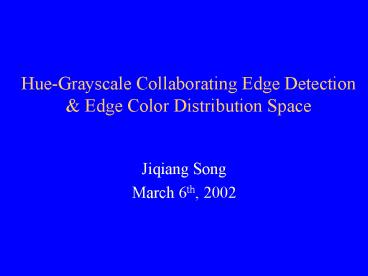HueGrayscale Collaborating Edge Detection - PowerPoint PPT Presentation
Title:
HueGrayscale Collaborating Edge Detection
Description:
Step 1: Generate Hue Edge Map (HEM) & Grayscale Edge Map (GEM) ... Merge HEM & GEM into a final Color Edge Map (CEM). HGC Edge Detector. Performance comparison ... – PowerPoint PPT presentation
Number of Views:77
Avg rating:3.0/5.0
Title: HueGrayscale Collaborating Edge Detection
1
Hue-Grayscale Collaborating Edge Detection
Edge Color Distribution Space
- Jiqiang Song
- March 6th, 2002
2
Introduction
- Definition of Edge in an image
- Shape transition of intensity and/or color
- Meaning of edge
- Outline of objects
- Image structure
- An important feature for image segmentation
object detection
3
Part 1 Hue-Edge Collaborating (HGC) edge
detection
- Existing edge detection methods
- Binary image
- Grayscale image
- Color image
4
Binary edge detector
HGC Edge Detector
- A foreground pixel P (P1) is an edge point if
its convolution result does not equal zero.
? 8-connected edges
? 4-connected edges
5
Grayscale edge detector
HGC Edge Detector
- Gradient operators
- Sobel, Prewitt, Roberts
- Second derivative operators
- Zero-crossing, LoG
- Others
- Canny, SUSAN
6
Color edge detector
HGC Edge Detector
- Multi-dimensional gradient methods
- Output fusion methods
7
Why to design a HGC edge detector?
HGC Edge Detector
- Grayscale edge detector ? gt90 of real edges,
fast. - Color edge detector ? more edges, slow.
- Our application video processing
- Thousands of images in a 10 minutes long video
(when sampling 34 images/second) - Color edge detector often over-detects edges.
8
Introduction of color models
HGC Edge Detector
- RGB
- R (red) G (green) B (blue)
- Grayscale
- Luminance, achromatic, 1 dimension
- HSI a perceptual color model
- H (hue) S (saturation) I (intensity)
- Others YUV, HIQ, CIE(Lab),
9
Grayscale vs. HSI
HGC Edge Detector
- RGB ? Grayscale
- g 0.299?R 0.587?G 0.114?B (0? g ? 1)
- RGB ? HSI
10
Grayscale vs. HSI (continued)
HGC Edge Detector
- The change of hue cannot be detected in grayscale
space. - The noticeable change of intensity or saturation
can be detected in grayscale space.
11
HGC edge detector
HGC Edge Detector
- Step 1 Generate Hue Edge Map (HEM)
Grayscale Edge Map (GEM) - Step 2 Overdetected edge minimization
- Step 3 Output fusion
12
Hue Edge Map Grayscale Edge map
HGC Edge Detector
- Convert a sampled RGB video image into a hue map
a grayscale map. - Use Sobel operator to detect edge strength
(gradient) in two maps. - Use a fuzzy threshold to generate edge maps.
13
Overdetected hue edge minimization
HGC Edge Detector
- ASSUME a valuable edge point must have a certain
connected length. - Extract hue edge points that are not grayscale
edge points. - Use a run-length transform (RLT) to calculate the
maximum connected length of an edge point in any
direction. - Remove edge points that are not of desired
connected length.
14
Output fusion
HGC Edge Detector
- Merge HEM GEM into a final Color Edge Map (CEM).
15
Performance comparison
HGC Edge Detector
- Compared methods
- A grayscale edge detector (Sobel)
- HGC edge detector
- A YUV color edge detector
- Compared aspects
- Speed
- Edge completeness
- Testing data real-life video images
16
Speed comparison
HGC Edge Detector
- HGC edge detector saves average 20 of processing
time compared to the YUV color edge detector.
17
Comparison of edge completeness
HGC Edge Detector
18
Comparison of edge completeness (continued)
HGC Edge Detector
19
Part 2 Edge Color Distribution Space
- Why introducing a Edge Color Distribution Space
(ECDS) ? - 2D edge space is crowded.
- Color is an important information to segment
different objects. - Object discussed here is uniform-color object or
textured object, not high-level object. - The discussed image is of width W, of height H,
and of 256-level grayscale.
20
Directional color operator
ECDS
- Get the directional average color of a point
- Edge point (x, y, g) 0?x?W, 0?y?H, 0?g?255
21
X-Y-G space ? ECDS
ECDS
- Quantization
- ECDS
- (x,y,g)?(mx,my,gl)
- Distance-weighted accumulation
22
Characteristics of ECDS
ECDS
- Spatial relation of an object in the image is
kept. - Objects of different colors are separated.
- The edge of uniform-color object is continuous.
- The edge of textured object is clustering.
23
ECDS a synthetic image
ECDS
24
ECDS a video image
ECDS
25
End.Thank you!































